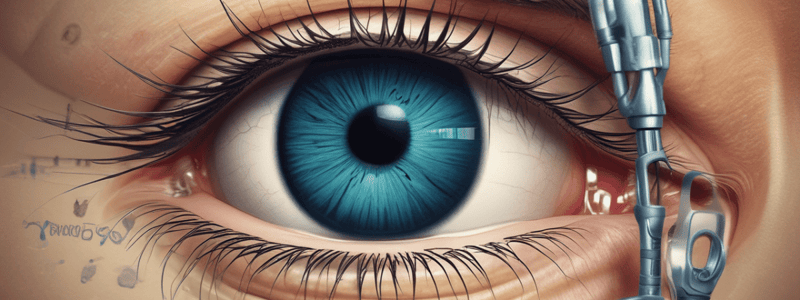Podcast
Questions and Answers
What is the term for the contraction of the anterior capsule after continuous curvilinear capsulorhexis?
What is the term for the contraction of the anterior capsule after continuous curvilinear capsulorhexis?
- Posterior capsular contraction
- Anterior capsular contraction syndrome (correct)
- Hyperopic shift
- Capsular opacification
Why was cycloplegia not performed routinely for streak retinoscopy in this study?
Why was cycloplegia not performed routinely for streak retinoscopy in this study?
- Because it is contraindicated in dogs with glaucoma
- Because it is not necessary for retinoscopy in canine eyes
- Because it significantly affects the refractive error outcome
- Because it does not significantly affect the refractive error outcome (correct)
Why were the retinoscopists not masked for IOL type?
Why were the retinoscopists not masked for IOL type?
- Because of the need for concurrent surgeries
- Because of the distinctive shapes of the IOLs used in this study (correct)
- Because of the limited number of IOLs available
- Because of the similar shapes of the IOLs used in this study
What was the method used to measure refraction in the study, and how many examiners were involved?
What was the method used to measure refraction in the study, and how many examiners were involved?
How many different IOLs were tested in the study, and what were their names?
How many different IOLs were tested in the study, and what were their names?
How often were refractions measured in the study, and when were they measured?
How often were refractions measured in the study, and when were they measured?
What was the result of the correlation analysis between the two examiners’ refraction measurements?
What was the result of the correlation analysis between the two examiners’ refraction measurements?
What device was used to measure corneal curvature in this study, and what were the values measured?
What device was used to measure corneal curvature in this study, and what were the values measured?
What was the purpose of performing gonioscopy in this study, and what instrument was used?
What was the purpose of performing gonioscopy in this study, and what instrument was used?
What was the frequency of the transducer used in amplitude modulation and bright-scan ultrasonography, and what values were obtained?
What was the frequency of the transducer used in amplitude modulation and bright-scan ultrasonography, and what values were obtained?
How many readings of the axial length and anterior chamber depth were taken at each session, and what was done with the readings?
How many readings of the axial length and anterior chamber depth were taken at each session, and what was done with the readings?
What was the duration of the study, and what type of patients were included?
What was the duration of the study, and what type of patients were included?
What was the purpose of performing binocular indirect ophthalmoscopy in this study, and what instrument was used?
What was the purpose of performing binocular indirect ophthalmoscopy in this study, and what instrument was used?
What type of agent was used to maintain the anterior chamber during the procedure?
What type of agent was used to maintain the anterior chamber during the procedure?
Why was the corneal incision enlarged with a keratome after lens extraction?
Why was the corneal incision enlarged with a keratome after lens extraction?
What was the purpose of the randomization table in the IOL implantation process?
What was the purpose of the randomization table in the IOL implantation process?
What type of suture was used to close the corneal incision?
What type of suture was used to close the corneal incision?
What medications were administered as subconjunctival injections at the conclusion of surgery?
What medications were administered as subconjunctival injections at the conclusion of surgery?
What is the primary outcome of capsule contraction syndrome after microincision foldable intraocular lens implantation?
What is the primary outcome of capsule contraction syndrome after microincision foldable intraocular lens implantation?
What types of medications were included in the standardized postoperative medication protocol?
What types of medications were included in the standardized postoperative medication protocol?
In which species have keratometry, biometry, and calculation of intraocular lens power been studied?
In which species have keratometry, biometry, and calculation of intraocular lens power been studied?
What is the purpose of retinoscopy in refractive state measurement?
What is the purpose of retinoscopy in refractive state measurement?
What is the significance of silicone oil tamponade in retinal reattachment?
What is the significance of silicone oil tamponade in retinal reattachment?
What is the importance of correlation analysis between examiners' refraction measurements?
What is the importance of correlation analysis between examiners' refraction measurements?
What is the significance of the Binkhorst and/or Retzlaff formulas in the context of IOL implantation in various species?
What is the significance of the Binkhorst and/or Retzlaff formulas in the context of IOL implantation in various species?
How did the study demonstrate the reliability of the formulas in ametropic dogs requiring custom IOLs?
How did the study demonstrate the reliability of the formulas in ametropic dogs requiring custom IOLs?
What were the limitations of the study, and how did they affect the refractive results?
What were the limitations of the study, and how did they affect the refractive results?
What were the causes of haptic luxation and IOL decentration in the study?
What were the causes of haptic luxation and IOL decentration in the study?
What was the significance of the postoperative follow-ups at 1 week, 1 month, and 3 months in the study?
What was the significance of the postoperative follow-ups at 1 week, 1 month, and 3 months in the study?
What are the implications of the study's findings for the use of custom IOLs in ametropic dogs?
What are the implications of the study's findings for the use of custom IOLs in ametropic dogs?
Flashcards are hidden until you start studying




